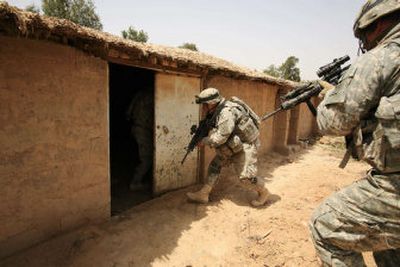Results of recent Iraq effort mixed

BAGHDAD – Gen. David Petraeus, the top U.S. commander in Iraq, said the ongoing increase of nearly 30,000 U.S. troops in Iraq has achieved “modest progress” but has also met with setbacks such as a rise in devastating suicide bombings and other problems that leave uncertain whether his counterinsurgency strategy will ultimately succeed.
Assessing the first two months of the U.S. and Iraqi plan to pacify the capital, senior American commanders – including Petraeus; Adm. William Fallon, head of U.S. forces in the Middle East; Lt. Gen. Raymond Odierno, commander of military operations in Iraq; and top regional commanders – see mixed results. They said that while an increase in U.S. and Iraqi troops has improved security in Baghdad and Anbar province, attacks have risen sharply elsewhere. Critical now, they said in interviews last week, is for Iraqi leaders to forge the political compromises needed for long-term stability.
The commanders search for ways to measure the success or failure of their efforts. On Friday night at dusk, Petraeus boarded a helicopter to look for small signs of normalcy and progress above the maelstrom of the capital.
“On a bad day, I actually fly Baghdad just to reassure myself that life still goes on,” he said, leaning back and propping his legs on the seat in front of him.
The aircraft banked right and Petraeus caught sight of a patch of relative calm. “He’s actually watering the grass!” Petraeus said with a laugh, peering down at a man tending a soccer field, with children playing nearby.
Seconds later, the aircraft pivoted again, exposing boarded-up shops on a deserted, trash-strewn street. A bit farther, along the Tigris River, a hulking pile of twisted steel came into view – the remains of the Sarafiya bridge, blown up April 12 amid a series of deadly suicide bombings.
“That’s a setback,” Petraeus said, his voice lower. “That breaks your heart.”
And so it went, all across the city. Directing the pilot to “break left” or “roll out,” he scanned the landscape for even tiny improvements – a pile of picked-up trash, an Iraqi police car on patrol, a short line at one gas station – as if gathering mental ammunition for the next wave of carnage. An amusement park, its rides lit up, merited a full circle.
“We have certainly pulled neighborhoods back from the brink,” Petraeus said, recalling his initial shock at the stark deterioration of parts of the capital upon his arrival in February.
The deployment of additional troops in Baghdad is 60 percent complete, and incoming units in many parts of the city are still conducting initial, labor-intensive operations to “clear” neighborhoods before setting up patrol bases, a pillar of Petraeus’ counterinsurgency plan. Iraq’s security forces have contributed the nine battalions pledged for the Baghdad operations and rotate those forces every 90 days.
The bases – which so far include 21 combat outposts and 26 joint security stations run together with Iraqi forces – are a key building block in the effort to increase security for Baghdad residents. Another part of the strategy is to wall off communities along their traditional boundaries to control population access and prevent attacks.
“That’s part of the concrete caterpillar,” Petraeus said, pointing out a barrier going up in a neighborhood in west Baghdad. “That market was shut completely down when I took command – now it has 200 shops,” he said.
The walls helped divert the multiple car bombs in Baghdad on Wednesday – three of which exploded short of their targets. The fourth and deadliest vehicle bomber was able to enter a market because someone had removed part of the barrier to gain easier access, U.S. officials said.
U.S. commanders say sectarian murders fell from 1,200 in Baghdad in January to fewer than 400 in March. Some markets are reopening, and a few thousand families have trickled back in to areas they fled.
But they agreed that among the most troubling trends in Iraq has been the proliferation of suicide bomb attacks, such as the Wednesday attacks, which all told killed more than 170 people, because they risk reigniting sectarian revenge killings and undermining the government. Suicide bombings have increased 30 percent over the six weeks that ended in early April, according to military data.
“I don’t think you’re ever going to get rid of all the car bombs,” Petraeus said. “Iraq is going to have to learn – as did, say, Northern Ireland – to live with some degree of sensational attacks.” A more realistic goal, he said, but one that has eluded U.S. and Iraqi forces, is to prevent the bombers from causing “horrific damage.”